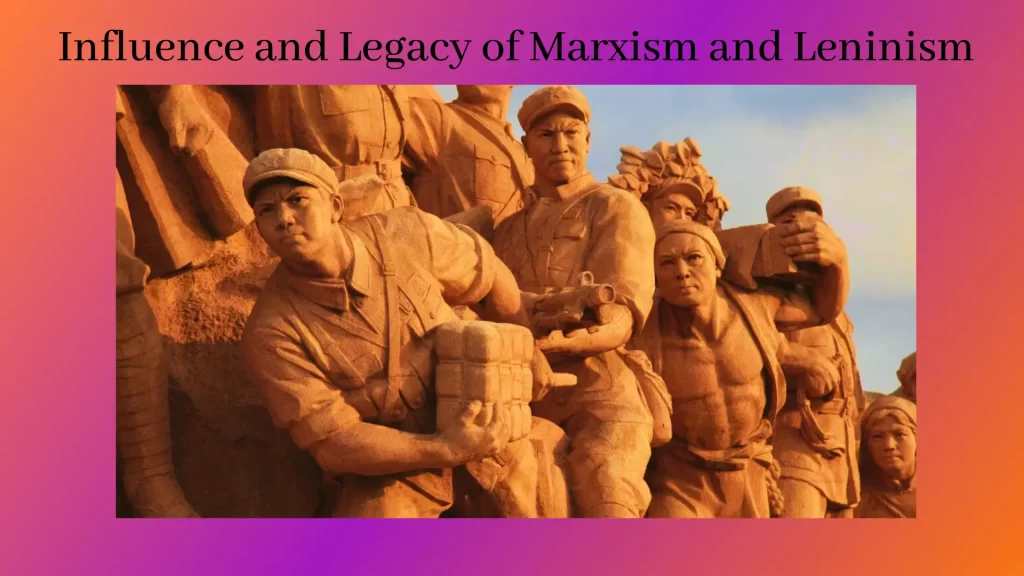Marxism and Leninism have had an indelible mark on history’s course since their debut. Marxism originated through Karl Marx’s writings while Leninism under the leadership of Vladimir Lenin emerged. Both ideologies share similar goals yet differ significantly in some regards. We will explore this article’s similarities, differences, impacts and influences associated with Marxism and Leninism to gain more of an insight into their impact and significance to society as whole.
Definition of Marxism and Leninism

Marxism:
Marxism emerged during the late 19th century from Karl Marx and Friedrich Engels’ work during this era as an economic theory with social implications, initially developed during their respective lifetimes. Marxist thought is an expansive model which criticizes capitalism while providing an outline for creating a socialist, eventually communist society.
Marxism relies upon dialectical materialism and historical materialism which consider the correlations among classes, methods of production, class struggle and distribution of riches across populations. Seeking abolishing private property holdings owned by private individuals while creating classless societies with all production tools owned by society as wholes.
Leninism:
Leninism was first proposed and developed by Vladimir Lenin as an expansion and application of Marxism. Leninism first emerged at the dawn of the 20th century and played an essential part in Russia’s revolutionary spirit and establishment of Soviet Union. Combining Marxist principles with Lenin’s ideas and modifications, this political ideology played an influential role.
Leninism stresses the role of vanguardist parties as catalysts of revolutionary activity within working class revolution, imperialism as the top level of capitalist society, as well as needing robust yet centralized state institutions during transition towards socialism. Additionally, Leninism places great importance upon peasantry struggles against imperialism around the globe.
Core Principles
- Dialectical Materialism: Marxism’s core ideology stems from dialectical materialism – an approach which analyzes historical and social events through their physical environment over time and their interrelation. Dialectical materialism emphasizes interactions among opposing forces as the driving force for social changes.
- Historical Materialism: Marxism employs historical materialism which asserts that society’s development is determined by conflict among class groups over production methods and analyzes how any change affects both its structure and relationships between classes.
- Class Struggle: Marxism states that society can be seen as being divided into classes that represent various social roles within it – these classes being the bourgeoisie (capitalists) and proletariat (workers). According to this belief, society’s development can be seen through class struggles as the ruling class seeks to protect its position while exploiting labor from workers.
- Marxism promotes the abolishing of private Property: Marxism calls for the elimination of private ownership over production methods such as factories or land and resources like water. Instead, ownership and control over these resources would be achieved via class struggle in order to establish a socialist society where resources are allocated based on need, not profits.
- Dictatorship of the Proletariat: Marxism presents the notion of the Dictatorship of the Proletariat during a transitional period between communism and capitalism, where workers exercise political power for reforming society while undercutting bourgeois interests to pave the way for communist classless societies to emerge.
Leninism:
- Vanguard Party: Leninism emphasizes the importance of a disciplined and centralized vanguard party composed of dedicated revolutionaries who serve as the political leadership and guide the working class towards revolution. Party membership represents the vanguard of proletariat mobilizing masses against capitalism.
- Imperialism and Imperialism as the Highest Stage of Capitalism: Leninism builds upon Marxism by recognizing imperialism as a stage of advanced capitalism. It analyzes how monopoly capitalism leads to the exploitation of colonies and the division of the world among imperialist powers. Leninists view anti-imperialist struggles as part of a wider class struggle that encompasses global affairs and their implications for anti-imperialist struggle.
- Revolutionary Tactics: Leninism advocates for revolutionary tactics, including armed struggle and insurrection, to overthrow the capitalist class and seize state power. They embrace various strategies involving mass mobilization, strikes and uprisings as tools to disrupt the current system and establish one governed by socialism.
- Socialist Revolution in Agrarian Societies: Leninism acknowledges the specific conditions of agrarian societies, where a large portion of the population consists of peasants. It recognizes the vital significance of forging alliances between peasantry and working class to make possible an effective socialist revolution.
- State and Revolution: Leninism Emphasizes State Importance during Socialism-to-Capitalism Transition Leninism emphasizes the significance of state during transitioning from socialism to capitalism, advocating the establishment of a proletarian state which exercises control over means of production while protecting revolutionary forces against counterrevolutionary attacks. Leninists view statehood as tool used by workers with the goal of dissolving once communism has taken hold.
Views on the State
Marxism:
- Critique of the Bourgeois State: Marxism presents an in-depth examination of bourgeois government, or state political apparatus serving capitalist interests. According to its author, this state with all of its legal, judicial, and coercive structures serves to preserve current capitalist systems by safeguarding private property while increasing power to those belonging to class of the bourgeoisie.
- Transition Toward Communism: Marxism envisioned an interim period between capitalism and communism known as the dictatorship of proletariat for which workers took political control of state institutions to dismantle capitalism, seize production methods and reform society according to socialist principles – using political power against its master class, with socialist ideals acting as an antidote thwarting their agenda of classism by building conditions conducive to classless societies.
- Withering Away of the State: Marxists hold that with the arrival of communism characterized by its complete destruction of classes and unequal distribution of resources, including resources used by government for social control purposes, states will eventually wither away and disappear altogether as social control decreases. Their existence will no longer be necessary, leading to their eventual demise as state institutions cease performing their role and roles no longer need performing by them.
Leninism:
- Revolutionary Vanguard Lead the Proletariat: Leninism emphasizes the necessity of an independent political vanguard party composed of committed revolutionaries committed to leading proletarian revolution against capitalism and creating socialism. Such parties provide direction as well as leadership during workers’ battle against capital. Lenin believed such parties served as weapons against state control by seizing control themselves to achieve its visions of socialism.
- The Need for a Strong State during the Transition to Socialism: Leninism advocates for the establishment of a powerful proletariat state during transitions from socialism to capitalism, in order to defend revolutionaries against counterrevolutionary forces, consolidate working class power and implement socialist policies. Such an entity would oversee methods of production as well as economic and political changes within society.
- The Role of the State in Defending the Revolution: Leninism emphasizes the role of state institutions in protecting revolution from external and internal threats, including class enemies as well as counterrevolutionary forces which threaten revolutionary processes. Thus, states have been charged with keeping order, suppressing radical elements, defending workers’ interests and keeping social harmony.
Marxism and Leninism both acknowledge the transitional role of government. Leninism tends to place greater importance on having an all-powerful and centralized state during periods of revolution while Marxism envisions an eventual non-stateless society for communism as its ultimate endgame goal.
Strategy and Tactics
Marxism:
- Marxism Places Emphasis on Economic Determinism: Marxism places an immense amount of importance upon economic determinism as being at the core of social change, often being seen through strikes and labor movements as key strategies and tactics used by Marxists to disrupt and change capitalist systems like our own. Strategies used by Marxists often consist of mobilizing and organizing workers’ struggles aimed at challenging capitalism at its source and overthrowing existing capitalist systems through disruption.
- Revolution through Mobilization of Working Class: Marxism advocates mobilization of working-class members as the cornerstone of revolution. Strategies and tactics seek to raise consciousness of workers across industries while uniting together into one powerful force capable of overthrowing capitalist rule – this may involve activities such as organizing unions, participating in strikes or engaging in political protests.
Leninism:
- Importance of a Disciplined Vanguard Party: Leninism places significant importance on the role of a vanguard party, composed of dedicated and disciplined revolutionaries. The vanguard party acts as the political leadership guiding the working class towards revolution. Strategies and tactics involve building and strengthening the vanguard party, developing its organizational capacity, and providing ideological and strategic direction to the broader revolutionary movement.
- Utilization of Revolutionary Tactics, Including Armed Struggle: Leninism recognizes the potential need for revolutionary tactics, including armed struggle, in the pursuit of socialist revolution. The tactics employed may include organizing armed uprisings, guerrilla warfare, and insurrections against the ruling class. These tactics are seen as necessary to seize state power and establish a socialist society.
- The Role of the Peasantry in the Revolution: Leninism recognizes the important role that peasants can play in creating revolution, particularly within agricultural societies. Strategies and tactics must include forging alliances between workers and peasantry alike for creating broad-based revolution. This includes addressing the specific concerns and grievances of the peasantry and mobilizing them as a revolutionary force alongside the proletariat.
Marxism and Leninism both acknowledge the criticality of revolutionary methods and techniques in changing and challenging capitalist systems. While Marxism tends to focus on economic justice issues and mass mobilization for workers’ class membership, Leninism extends this idea by emphasizing vanguard parties, armed struggle as necessary means, as well as peasants joining in revolutionary actions.
Differences between Marxism and Leninism

Marxism and Leninism share certain similarities. There are key distinctions in their approaches and theories that make each distinct from one another. Here are a few key distinctions between them both:
- Vanguard Party: One key difference between Marxism and Leninism lies in their respective views on vanguard political parties. Leninist ideology stresses the necessity of having an experienced revolutionaries act as political guides during revolutionary struggles; Marxism does not explicitly recommend vanguard political parties as being essential components for revolution.
- Role of the State: It is equally essential to note the role played by the state during transition from socialism to capitalism. Marxist theory generally advocates for its gradual dismantlement when communism becomes reality and points towards its eventual removal altogether. Leninism acknowledges a powerful proletariat-led state as part of this transitional phase, to protect and consolidate revolutionary power consolidation while carrying out socialist policies effectively.
- Imperialism and Capitalism: Leninism introduces imperialism as the top level of capitalism, including dominating monopolies, partition of world between imperialistic powerhouses, as well as any anti-imperialist struggles which form part of global class struggle. This view differs significantly from Marxism which acknowledges some aspects of capitalistic exploitation without going as deeply into imperialism complexities.
- Peasants in Revolution: Leninism holds that peasants play an integral part in revolution, particularly within agricultural societies, Lenin stressed how vitally important connections were between working-class and peasantry for its success, while Marxism emphasizes industrial class transformation as its driving force for change.
- Revolutionary Tactics: Due to Leninism’s focus on vanguard groups and particular circumstances associated with the Russian Revolution, Leninism places more of an emphasis on revolutionary strategies like armed struggle or insurrection than Marxism does instead it stresses an organic growth of class struggle rather than prescribing specific strategies and tactics for revolution.
Leninism should be understood in relation to Marxism within the Russian Revolutionary context, particularly Lenin as its embodiment. Lenin used Marxist theory and expanded it further for application within Russia’s specific circumstances by formulating revolutionary plans. Regardless of any differences between Marxism and Leninism they do share an underpinning foundation and should therefore not be separated.
Similarities between Marxism and Leninism
Marxism and Leninism share several similarities, as Leninism is considered a development and application of Marxism. Here are some key Similarities between the two:
- Historical Materialism: Both Marxism and Leninism have roots in historical materialism, the study of society through class struggle as well as material production conditions. Both ideologies recognize economic influences’ importance in shaping social relationships over time as societies evolve over time.
- Critical Analysis of Capitalism: Both Marxism and Leninism share an animus towards capitalism as an institution, seeing its systems as characterised by class inequities, exploitation and contradictory elements that need to be transcended to create equitable societies. They advocate that transcending capitalism must occur for an equitable and just society to exist.
- Class Conflict: Both ideologies emphasize the significance of class struggle for revolutionizing history. Both Marxism and Leninism advocate liberation of working classes by supporting their leadership role during revolutions.
- Abolition of Private Property: Marxism and Leninism advocate the elimination of private ownership over tools of production. Both theories advance collective ownership and control over resources productive for production purposes – creating a society in which resources and wealth are allocated according to need rather than profit maximization.
- Transition into Communism: Marxism and Leninism both envisage an intermediate period between communism and capitalism known as proletariat dictatorship which will ultimately give way to socialist society where working class people occupy political power positions in its government – eventually reaching classless status with no state remaining behind it all.
- Internationalism and Anti-Imperialism: Both emphasize the significance of international solidarity and anti-imperialist struggle as key features. Both ideologies see imperialism as the result of advanced capitalism and seek to unite working class communities worldwide against imperialism’s exploitation and dominance.
Leninism represents an expansion and application of Marxism within Russia during its revolutionary context; yet its basic concepts and principles remain similar to its counterpart. Leninism often serves as a modification or interpretation of Marxism to adapt it for use within Russian conditions and provide innovative strategies for workers’ struggle.
Influence and Legacy of Marxism and Leninism

Marxism and Leninism have had an Unparalleled effect on economic, political and social developments around the globe for generations to come. Here are a few key aspects of their legacy which need to be kept in mind by contemporary society:
Marxism:
- Marxism’s Role in Socialism and Communism: Marxism has played an influential role in communist and socialist movements around the globe for nearly 200 years. Providing both theoretical backing and inspiration to political parties, labor movements and revolutionary struggles striving to transform capitalism and create more equitable societies.
- Social and Economic Theory: Marxist theory has had significant ramifications on both economic and social theory. Through its criticisms of capitalism, study of class struggle, and focus on materialist views of history it has had an immense influence across various fields, including economics, sociology, political studies and cultural studies.
- Class Consciousness and Workers Rights: Marxism has played an instrumental role in raising class consciousness and recognizing workers rights, aiding in the rise of trade unions as well as fighting for better working conditions, fair pay and social rights for workers.
- Marxism’s Critique of Inequality and Exploitation: Marxism’s criticism of social exploitation, inequality and wealth monopolization provides a foundation to understand and confront social injustices as well as influence groups that pursue equality, social justice and redistribution.
Leninism:
- Implementation in Revolutionary Practice: Leninism was developed from an application of Marxist theory specifically tailored to meet the particular circumstances surrounding the Russian Revolution and subsequent revolutionary movements, providing both strategic and institutional structures for revolutionary action with emphasis being given on vanguard parties, armed struggle and seizing power from state institutions.
- Formation of Socialist States: Leninism’s lasting impact can be seen through its legacy: socialist states such as those established within the Soviet Union. Leninist ideology contributed towards creating this type of state with nationalized industries and collectivization agriculture practices as well as central planning being introduced and maintained throughout this era.
- Lenin’s Influence upon Anticolonial and Anti Imperialist: Movements Lenin’s critique of imperialism and call to anti-imperialist struggle have had an enduring influence upon anticolonial and antiimperialist movements worldwide, particularly those struggling against colonization or oppression in Africa, Asia and Latin America. Leninist concepts provided a basis for resistance against imperial and colonial power structures.
- Marxist-Leninist Party’s Development: Leninism laid the groundwork for Marxist-Leninist parties across the globe to take shape; these parties played key roles during revolutions as well as socialist governance and political activism during 20th Century revolutions and political uprisings.
Marxism and Leninism’s legacy should not be taken for granted as its impact and application have varied widely throughout time and across contexts. Although their theories had an immense effect on history, critics and other individuals and groups found fault with certain aspects or even interpretations or modifications made over time.
Criticisms of Marxism and Leninism
Marxism and Leninism, like any political ideologies, have faced criticism from various perspectives.
Here are some common criticisms:
- Totalitarianism and Authoritarianism: Critiques of Marxism or Leninism often concern its potential to concentrate power among an elite few, or vanguard group. Critics state that implementation of Marxist and Leninist ideas have resulted in dictatorial regimes which restrict political freedoms, suppress dissent individual liberties and violate human rights.
- Lack of Individual Freedom and Property Rights: Some critics allege that Marxism and Leninism threaten individual liberty as well as private property rights. The collectivist nature of these ideologies, which emphasize collective ownership and central planning, can be seen as infringing upon individual liberties and stifling entrepreneurship and innovation.
- Economic Inefficiency and Lack of Market Mechanisms: Critics contend that the centralized planning and state control advocated by Marxism and Leninism lead to economic inefficiencies, resource misallocation, and lack of market mechanisms to determine prices and allocate resources efficiently. They argue that without the incentives provided by market forces, innovation and productivity suffer.
- Ignoring the Diversity of Human Nature and Culture: Critics argue that Marxism and Leninism oversimplify human nature and ignore the diversity of cultural, social, and historical contexts. These researchers contend that current theories do not take into account the complex motivations and cultural distinctions exhibited by individuals as well as human ambitions that lead to animosity and suppression between cultures or identities of differing types.
- Inadequate Political Pluralism and Democracy: Critics argue that Marxism and Leninism, in their implementation, often suppress political pluralism and limit democratic processes. Concentration of power by one dominant group or elite may restrict political freedom, expression and the inclusion of diverse opinions into decision making processes.
- Failure of Historical Examples: Critics point to the failure or shortcomings of historical attempts to implement Marxism and Leninism, such as the Soviet Union and other socialist states. They argue that these examples demonstrate the impracticality or inherent flaws of these ideologies in achieving their stated goals.
Important to keep in mind is that these critiques do not represent all views regarding Marxism and Leninism. There exist different opinions, perspectives, and reactions outside these ideologic contexts that relate to criticisms made about them.
Summary
Marxism and Leninism stand as powerful ideologies that have shaped the course of history. Rooted in a desire for a fairer society and a rejection of exploitation, these theories have inspired revolutions, toppled empires, and ignited social movements. Their influence endures, albeit in diverse forms and interpretations, and their impact on politics and social justice remains undeniable.


